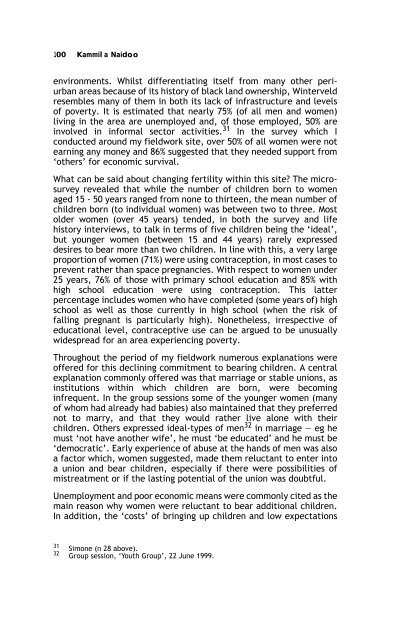Sex, Gender, Becoming - PULP
Sex, Gender, Becoming - PULP
Sex, Gender, Becoming - PULP
Create successful ePaper yourself
Turn your PDF publications into a flip-book with our unique Google optimized e-Paper software.
100 Kammila Naidoo<br />
environments. Whilst differentiating itself from many other periurban<br />
areas because of its history of black land ownership, Winterveld<br />
resembles many of them in both its lack of infrastructure and levels<br />
of poverty. It is estimated that nearly 75% (of all men and women)<br />
living in the area are unemployed and, of those employed, 50% are<br />
involved in informal sector activities. 31 In the survey which I<br />
conducted around my fieldwork site, over 50% of all women were not<br />
earning any money and 86% suggested that they needed support from<br />
‘others’ for economic survival.<br />
What can be said about changing fertility within this site? The microsurvey<br />
revealed that while the number of children born to women<br />
aged 15 - 50 years ranged from none to thirteen, the mean number of<br />
children born (to individual women) was between two to three. Most<br />
older women (over 45 years) tended, in both the survey and life<br />
history interviews, to talk in terms of five children being the ‘ideal’,<br />
but younger women (between 15 and 44 years) rarely expressed<br />
desires to bear more than two children. In line with this, a very large<br />
proportion of women (71%) were using contraception, in most cases to<br />
prevent rather than space pregnancies. With respect to women under<br />
25 years, 76% of those with primary school education and 85% with<br />
high school education were using contraception. This latter<br />
percentage includes women who have completed (some years of) high<br />
school as well as those currently in high school (when the risk of<br />
falling pregnant is particularly high). Nonetheless, irrespective of<br />
educational level, contraceptive use can be argued to be unusually<br />
widespread for an area experiencing poverty.<br />
Throughout the period of my fieldwork numerous explanations were<br />
offered for this declining commitment to bearing children. A central<br />
explanation commonly offered was that marriage or stable unions, as<br />
institutions within which children are born, were becoming<br />
infrequent. In the group sessions some of the younger women (many<br />
of whom had already had babies) also maintained that they preferred<br />
not to marry, and that they would rather live alone with their<br />
children. Others expressed ideal-types of men 32 in marriage — eg he<br />
must ‘not have another wife’, he must ‘be educated’ and he must be<br />
‘democratic’. Early experience of abuse at the hands of men was also<br />
a factor which, women suggested, made them reluctant to enter into<br />
a union and bear children, especially if there were possibilities of<br />
mistreatment or if the lasting potential of the union was doubtful.<br />
Unemployment and poor economic means were commonly cited as the<br />
main reason why women were reluctant to bear additional children.<br />
In addition, the ‘costs’ of bringing up children and low expectations<br />
31<br />
Simone (n 28 above).<br />
32 Group session, ‘Youth Group’, 22 June 1999.
















